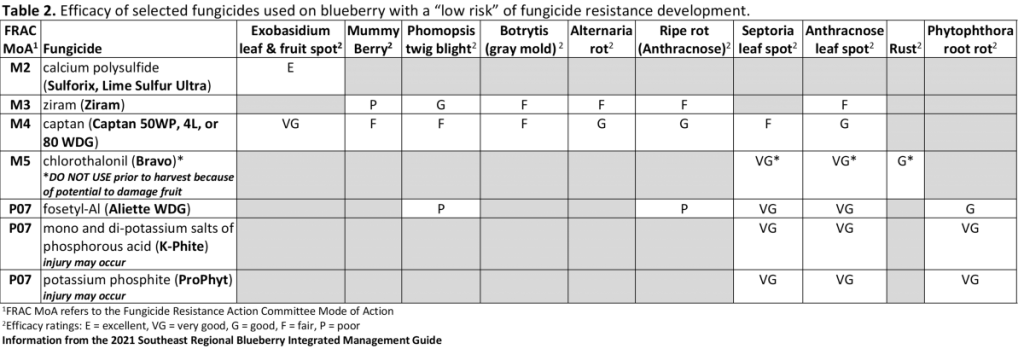In conventional blueberry production, fungicides are frequently used to manage blueberry diseases. Unfortunately, as a result of repeated fungicide usage, the fungi targeted by these chemicals can develop resistance to specific fungicide modes of action. This ultimately can make these fungicides less effective for disease management. To reduce the chances of this occurring, growers are encouraged to practice good fungicide resistance management practices, including rotating the available modes of action and utilizing multisite, low-risk fungicides for disease management wherever possible.
Based upon their modes of action, fungicides can be classified into two general groups that describe the risk that fungal organisms will develop resistance to these fungicides (Table 1). These include: (1) moderate to high risk, single-site mode of action fungicides and (2) low risk, multisite mode of action fungicides. For conventional blueberry production in Georgia, one of the most commonly utilized multisite fungicides is captan. (Captan is called a ‘multisite’ fungicide because it works to control fungal diseases by targeting multiple processes in the lifecycles of numerous blueberry disease-causing fungi [rather than a single process].) Due to its multisite nature, fungi are not able to easily develop resistance to captan, and as a result, growers are strongly encouraged to apply products containing captan either singly or in compatible tank mixes with single-site fungicides to preserve their efficacy in the long-term.

Recently, I have received multiple questions regarding other multisite fungicides for blueberry and whether they are suitable as a captan “substitute”. The simple answer to that question is that there are no other fungicides recommended for blueberry that truly can serve as a captan substitute in all circumstances (see the latest edition of the Southeast Regional Blueberry IPM Guide at https://smallfruits.org/ipm-production-guides/ for further details). Nonetheless, for growers seeking other products that can, in part, fill the role of captan in their spray program, the most comparable fungicide recommended for blueberry is ziram. Like captan, ziram is also a multisite fungicide that has efficacy against a variety of fungal organisms (Table 2). Furthermore, regarding tank mixes of ziram, the label for Ziram 76DF indicates that this product “is compatible with most commonly used pesticides and adjuvants” and it “may be used with systemic fungicides … for broad-spectrum disease control”1. One major limitation on the use of ziram on blueberries, however, regards the use of this product after bloom. Specifically, the labels for ziram containing products state “Do not apply later than 3 weeks after full bloom.” Based on this restriction, ziram cannot fill the role that captan does during late cover and pre-harvest sprays.

For after harvest disease control, another multisite fungicide recommended in the SE Regional Blueberry IPM Guide is chlorothalonil. This product, typically sold under the trade name Bravo, has been shown to be effective against a variety of foliar pathogens of blueberry including Septoria leaf spot, Anthracnose leaf spot, and Blueberry leaf rust. Unfortunately, the use of chlorothalonil on blueberry prior to harvest is not recommended because of its potential to damage fruit. Other low risk fungicides utilized in blueberries for after harvest leaf spot control include the phosphonates (Aliette, K-Phite, ProPhyt, Reliant, etc.). However, these products are not recommended for control of many preharvest diseases including mummy berry, Phomopsis twig blight, or common fruit rots, and accordingly would also not be an appropriate substitute for the broad-spectrum, multisite activity provided by captan prior to harvest.
Disease management recommendations for blueberries can be found in the Southeast Regional Blueberry Integrated Management Guide at smallfruits.org. Consult the various labels for rates, other recommendations, and precautions.
(1As always, refer to the labels of potential tank mix partners to determine if specific tank mixes are allowed or recommended. For more information on determining pesticide compatibility, see this article [https://www.canr.msu.edu/news/make_sure_products_are_compatible_when_tank_mixing_spray_partners]).